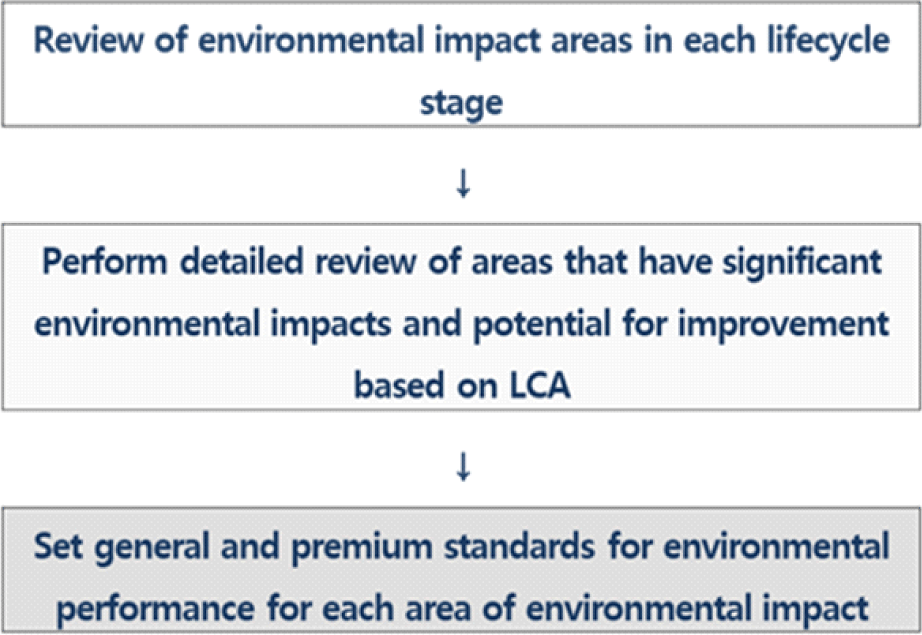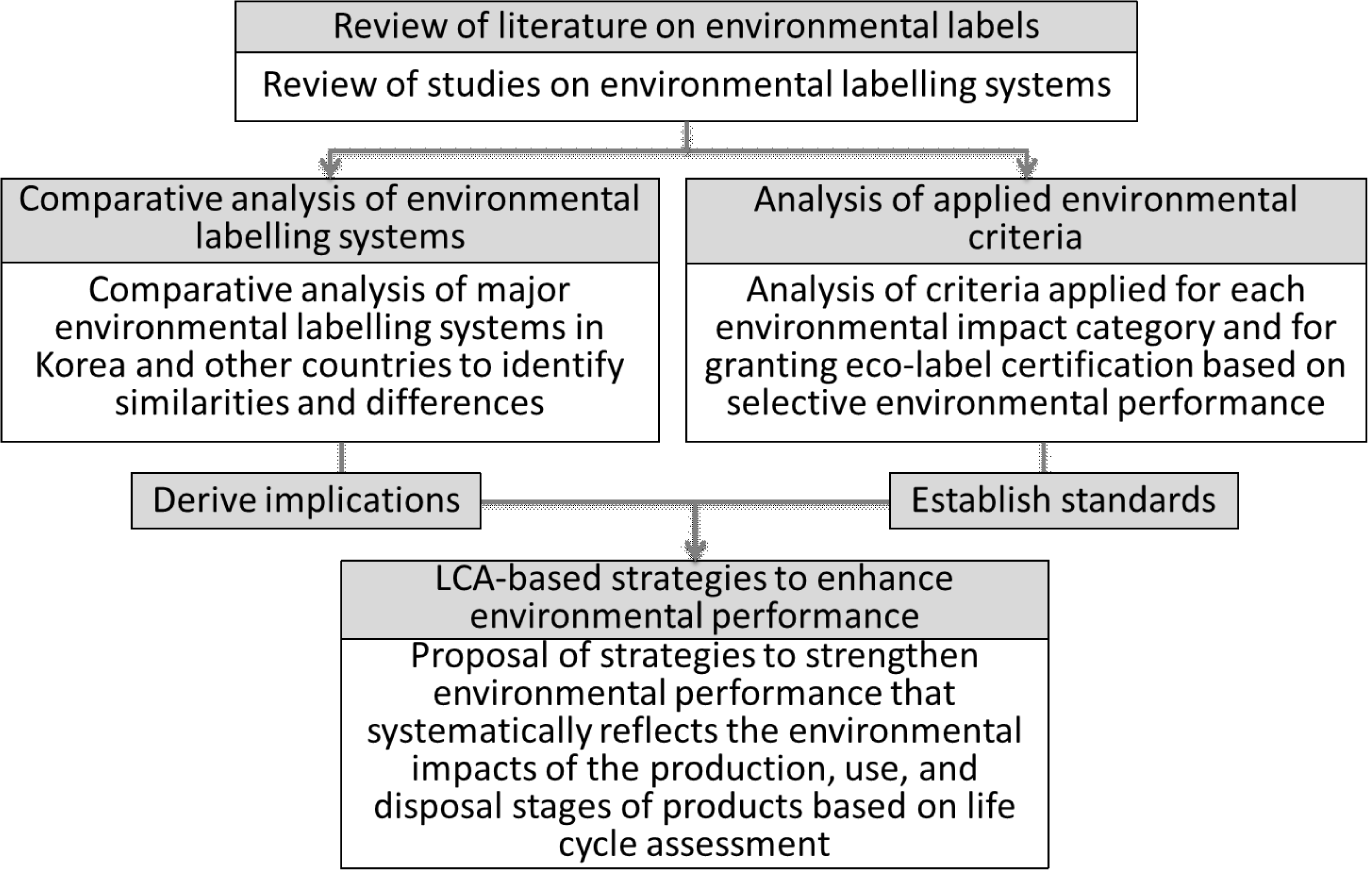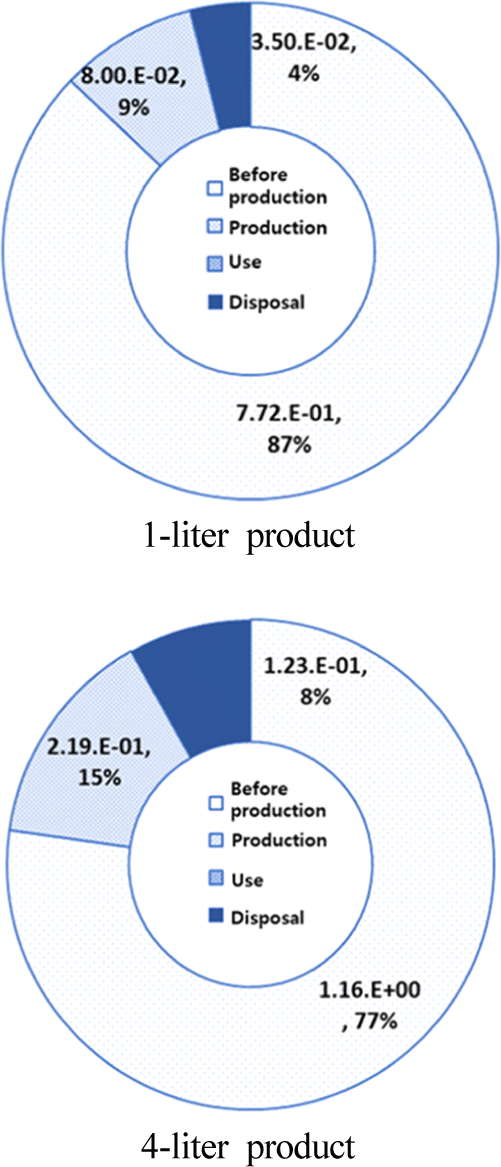1. 서 론
현재 인간의 활동이 지구 환경에 미치는 영향은 지속적으로 증가하고 있으며, 이에 따라 환경 보호와 지속가능한 발전을 위한 다양한 노력이 필요하다. 환경라벨링 제도는 소비자에게 제품의 환경성능을 알리는 중요한 수단으로 자리 잡고 있으며, 이를 통해 환경친화적 소비를 촉진하고 기업의 환경 책임을 강화할 수 있다. 한국의 환경표지는 1992년 4월부터 시행되어 왔으며, 자원, 에너지, 지구적 오염, 지역적 오염, 유해물질, 생활환경, 소음진동의 7대 환경부하를 기준 원칙으로 운영하고 있다. 또한, 원료취득, 제조, 유통·소비, 폐기, 재활용의 단계별 영향 여부를 판단하여 한국환경산업기술원에서 인증한다. 본 논문에서는 국내외 환경라벨링 제도의 현황과 특징을 비교분석하고, 전과정평가(Life Cycle Assessment, LCA)에 기반한 환경성 강화 방안을 제시하였다.
2. 연구방법 및 내용
본 연구는 국내외 환경라벨링 제도의 현황 및 특징을 파악하고, LCA를 통한 환경성 강화 방안을 제시하기 위해 체계적인 접근을 사용하였다. 연구의 체계는 Fig. 1과 같다.
3. 연구결과 및 고찰
ISO 환경라벨링 기준 인증 규격 기준은 아래와 같이 3가지로 나뉜다.
-
- ISO 14024(환경표지, 제1유형): 이 제도는 제품의 환경성과 품질 기준을 설정하여, 기준에 부합하는 경우 환경표지를 인증하는 것이다. 주로 동일 제품군 중에서 상위 20%의 탁월한 상품에 환경표지를 부여한다.
-
- ISO 14021(환경성 자기주장, 제2유형): 생산자가 제품의 환경성을 주장할 수 있는 방법과 조건을 설정하는 제도이다. 소비자의 혼란과 기만행위를 방지하기 위해 환경적 특성의 주장 방법과 조건을 규정한다.
-
- ISO 14025(환경성적표지, 제3유형): 제품의 전과정 평가(LCA)를 기반으로 환경성을 계량적으로 분석하고, 이를 인증하는 제도다. 제품 이용자에게 정확한 환경정보를 제공하여, 환경적 수요에 맞는 제품의 소비를 유도하며, 생산 단계에서 계량적 환경 관리 체계를 구축하도록 장려한다.
제1유형은 1979년 독일에서 블루엔젤(Blue Angel) 제도를 도입한 이후, 주로 선진국을 중심으로 발전해 왔다. 가장 잘 알려진 환경라벨링 제도는 제1유형에 속하며, 캐나다의 에코로고(Eco Logo), 북유럽의 노르딕스완(Nordic Swan Label), 일본의 에코마크(Eco Mark), EU의 에코라벨(Ecolabel, EU Flower), 대만의 그린마크(Green Mark), 중국의 환경라벨(Environmental Label), 프랑스의 NF Environment, 그리고 한국의 환경표지가 이에 해당한다[1].
이 제도는 ISO 14024에서 규정한 국제표준을 기반으로 하며, 전과정 사고(LCT, Life Cycle Thinking)를 고려하고 과학적인 품목별 인증 기준을 가져야 한다는 원칙을 따른다. 또한, 이 제도는 비차별적이어야 한다. 각국의 제도 운영기관은 국제 환경라벨링 네트워크(GEN)를 구성하여 회원국 간 상호인정협정을 추진하고 있다.
Table 1에 정리한 바와 한국, EU, 독일, 북유럽, 일본, 중국, 호주, 뉴질랜드, 캐나다 등은 각기 다른 기준으로 환경표지 인증을 운영하고 있다[2−4].
한국은 7대 환경부하 기준, EU는 생태학적 기준, 독일은 환경적·사회적·경제적 요건을, 북유럽과 일본은 전과정 환경영향과 자원순환을 각각 중시한다. 중국과 호주는 민간 또는 연합 인증을 통해 많은 제품을 인증하고 있으며, 캐나다는 전체 수명주기를 검토하여 인증한다.
제3유형(환경성적표지)은 1992년 미국의 Scientific Certification System(SCS)이 처음 도입한 이후, 여러 나라에서 시행되고 있다. 이 제도는 ISO 14025:2006 국제표준을 따르며, 제3자의 LCA를 통해 인증된다[5].
환경성적표지(EPD)는 과학적·정량적 기준을 만족시켜야 하며, LCA 결과를 공개하여 정보가 전문적이다. EU는 다양한 규제를 통해 LCA를 강화하고 있으며, 이에 따라 제3유형 라벨링의 중요성이 점점 높아질 것으로 예상된다.
우리나라의 환경표지인증과 환경성적표지인증은 「환경기술산업법」 제17조, 제18조에 근거하여 시행되고 있으며, ISO 환경라벨링 기준에 따라 환경표지 인증은 제1유형, 환경성적표지 인증은 제3유형에 해당한다. 그러나 현재 우리나라의 환경표지 제도는 제품의 환경성을 충분히 표시하지 못하는 한계가 있다. 이는 주로 LCA를 포함하지 않기 때문이다.
따라서, 우리나라는 환경표지의 개선을 위해 LCA에 기반한 환경성 강화를 추진해야 한다. 북유럽과 일본처럼 LCA를 기반으로 한 개선방안을 마련함으로써 보다 정확한 환경정보를 제공할 수 있을 것이다.
Table 2에 정리한 바와 같이 환경표지는 1994년에 근거법이 법령 제정되었으며, 지속적으로 개정되어 왔다[6−31].
주요 변화로는 1997년 국제 환경라벨링 네트워크(GEN) 가입과 1999년 환경마크 대상 제품 확대가 있다. 2001년에는 전기·전자제품에 대한 환경마크 기준이 마련되고, 환경성적표지제도가 도입되었다. 이후, 2005년에는 친환경상품 구매촉진에 관한 법률이 시행되었다. 2011년에는 서비스 품목으로 환경마크 인증이 확대되었고, 2015년에는 환경마크제도가 온라인화되었다. 2021년에는 플라스틱 사용을 줄이기 위한 개정안이 행정예고되었다. 이러한 개정들은 친환경 제품의 생산과 소비를 장려하고, 국제적 기준에 부합하도록 환경표지를 발전시켰다. 또한 2022년에는 프리미엄 인증대상 품목을 확대하고, 다회용기 대여서비스의 인증기준 등 생활밀착형 품목을 신설하였다.
환경표지의 품목 확대와 인증기준 강화와 관련된 개정사항을 정리하면 다음과 같다.
국내의 환경표지 환경성 기준 적용 방식을 분석하고, 국외 주요 환경라벨링 제도와의 공통점과 차이점을 도출하여 추가적인 환경성 기준 마련에 대한 개선방안을 검토하였다.
환경표지 제도와 국외 환경라벨링의 적용기준의 공통점과 차이점을 비교하였다. OECD 기준 12개의 범주와 한국에서 다루는 소음진동 범주을 추가하여 13개 환경지표를 기준으로 표지 대상을 검토한 결과, Table 3과 같이 환경라벨링마다 대상으로 삼고 있는 환경지표가 6−12개로 상이함을 알 수 있었다[32−37]. 한국의 7대 환경부하(자원, 에너지, 지구적 오염, 지역적 오염, 유해물질, 생활환경, 소음진동)를 OECD 기준으로 검토한 결과 8개의 환경지표를 다루고 있는 것으로 분석되었다.
국내의 환경표지 제도의 적용기준을 분석하고, 해외 주요 환경라벨링 제도와의 공통점과 차이점을 도출한 결과 탄소저감 등 환경영향 범주의 확대에 따른 환경성 강화가 필요한 것으로 분석되었다.
국외 주요 제1유형 환경라벨링제도는 모두 제품의 전과정을 고려하여 인증하나, 전과정평가(LCA)를 반드시 시행하는 것은 아니고, 전과정 단계별 환경영향을 고려한 인증을 시행하고 있다. 유럽, 일본 등에서는 인증기준의 유효기간(보통 3−5년)을 설정하여 주기적으로 심사하며, 유럽의 경우 인증기준 설정, 심의, 인증기관이 각각 다른 경우가 일반적이고 나머지 국가들의 경우 한 기관에서 인증기준 설정, 심의, 인증을 시행한다.
<ISO 14024(유형 1 환경라벨링) 규정>에 의하면, 3.1, 5.4, 5.6, 6.4 등에서 ‘제품의 전과정(자원추출-생산-분배-사용-폐기)을 고려하여’ 인증할 것을 권고하고, 5.8.1, 5.8.2에서 인증기준을 사전에 규정된 기간 내로 설정하며, 기간 내에 최신 현황을 고려하여 검토할 것을 명시하였다.
환경표지 제도의 운영 특성 중 하나인 ‘선택성(selectivity)’1)을 고려한 인증기준 설정 방법 및 절차 방안 개선은 상위 30% 제품이라는 명시된 비율과 관련한 명확한 법적 근거는 부재하나, 제도운영취지(「환경기술 및 환경산업지원법」 제17조) 및 국제표준(ISO 14024)에 근거하여 핵심 환경성 기준 설정 과정에서 선택성 고려가 필요해서 추진되었다.
EU Ecolabel의 경우, 특정 기준(criteria)이 아니라 각 기준에 해당되는 제품은 동종제품들 중 친환경성 측면에서 상위 10−20%에 속하는 경향이 있다고만 언급되어있고, 상위 몇 퍼센트 기준은 심사기준에 해당되지 않는다.
중장기 전략으로는 심사를 통과한 제품이 10−20% 이내로 우수하게 유지되도록 인증기준의 주기적 상향이 필요하다.
환경성적표지 탄소발자국은 LCA(전과정 평가)에 근거하여 제공되는 정보로 인해 환경성 평가 결과의 신뢰성이 높다. 반면, 환경표지는 이러한 평가에 기반한 정보를 충분히 반영하지 못하는 경우가 있다. 따라서, 환경표지의 인증기준을 더욱 정교하게 마련하기 위해 환경성적표지의 제품군별 환경성적을 활용할 필요가 있다. 이를 통해, 현재 시장에서 유통 중인 제품들을 평가하고, 환경표지의 인증기준이 상위 30% 수준을 유지하고 있는지를 지속적으로 모니터링할 수 있을 것이다.
환경표지 인증기준을 더욱 정교하게 마련하기 위해 환경성적표지의 결과를 반영하는 분석사례로 다음과 같이 주방세제를 들 수 있다. 특정 브랜드의 주방세제에 대한 분석 결과, 주방세제의 경우 제조 전 단계가 77−87%로 탄소배출에 기여하며, 대용량 제품일수록 사용과 폐기 단계 탄소배출량이 높은 것으로 분석되었다. 다만 리터당 기능단위를 적용할 경우 대용량의 탄소배출이 적은 것으로 나타났다(Fig. 2)[38]. 이러한 분석을 통해, 단순히 제품별 환경성에 따라 환경표지를 부여하는 것보다, LCA에 근거한 환경성을 평가하여 단계별 환경성과 기능단위에 따른 차등화된 환경표지를 부여하는 것이 필요하다. 예를 들어, 주방세제의 경우 제조 전 단계에서의 탄소배출을 줄이고, 리터당 탄소배출량이 적은 제품에 환경표지를 부여함으로써, 환경표지의 ‘선택성’ 기준을 강화할 수 있을 것이다.
ISO TypeⅠ은 “Life Cycle Considerations”를 규정하고 있어 ‘전과정단계’에 대한 인증 기준 구분 관리가 필요하다. 전과정단계인 제품의 생산·사용·폐기 과정에서의 환경부하를 재검토하고, 환경부하 등을 고려하여 세부 인증기준(항목, 기준치 등)의 재설정이 필요하다.
이에 환경표지 프리미엄 인증기준은 ISO 14020 및 ISO 14024의 요건에 따라 정하였으며, 전과정 사고(life cycle thinking)에 따른 제품의 전과정 단계를 원부자재 생산, 제품 제조, 수송, 사용, 폐기단계로 구분하여 인증기준안을 설정하였다(Fig. 3).

인증기준 설정시 환경성 강화를 위한 고려사항은 다음과 같다.
-
1) 기업이 탄소중립을 선도할 수 있도록 환경표지 인증시 탄소저감을 공통기준으로 적용하고 개별 기준(제품군별 설정)에 탄소배출 저감기준 강화: 저탄소 소재 활용 제고를 위해소재별 탄소 집약도(탄소 배출계수)를 평가하여 탄소 배출량이 낮은 소재 적용 확대
-
2) 순환경제 기여제품 인증확대 및 자원순환 환경성 강화: 자원순환성 향상, 재생원료 사용, 재사용, 수명연장 등 요소 인증기준 마련 필요
-
3) 국민의 신뢰도 제고를 위해 생활밀착형 제품을 중심으로 환경보건(유해물질 등) 기준 강화: 욕실용품, 위생용품, 유아용품, 실내용 건축자재 등 인체 위해성 저감에 대한 강화된 평가기준 적용
위의 고려사항을 검토하여 ISO 14020의 요건에 따른 전과정 사고를 반영하여 단일 환경이슈가 아닌 다중 환경이슈를 반영할 필요가 있다. 이에 최근 국제사회의 환경정책 동향을 반영하여 다중 환경이슈를 순환경제(circular economy), 탄소감축(carbon reduction), 환경보건(environment & health), 기타(others)로 구분하여 인증기준안을 마련하였다.
현재는 7대 환경성, 18개 관리목표가 있고, 169개 제품군, 7대 환경성을 전과정 단계별(원료취득/제조/유통‧소비‧사용/폐기/재활용)로 구분한 총 620개 기준에 따라 인증 여부를 평가한다. 7대 환경성별로는 유해물질 감소(199개, 32.1%), 자원순환성 향상(171개, 27.6%)이 주요하며, 생산 단계별로는 유통‧소비‧사용단계(281개, 45.3%), 제조단계(188개, 30.3%) 가 대부분을 차지하고 있다. 이러한 기존 인증기준을 7대 환경성, 18개 관리목표로 포괄적으로 설정하고, 탄소감축, 순환경제 등 시의성이 필요한 정책현안을 반영할 필요가 있다.
Table 4에는 개선된 인증기준 설정(안) 예시를 나타내었다.
4. 결 론
우리나라의 유형 1 환경표지 제도는 제품의 환경성을 표시하는 데 있어 몇 가지 한계를 지니고 있다. 현재 이 제도는 주로 자원 및 에너지 사용, 오염물질 배출 등의 기준을 기반으로 운영되지만, 제품의 전체 생애 주기를 포괄적으로 평가하지는 못하고 있다. 이로 인해 제품의 실제 환경 영향을 충분히 반영하지 못할 수 있다.
이를 해결하기 위해 LCA에 기반한 환경성 강화가 필요하다. LCA는 제품의 원료 채취부터 제조, 사용, 폐기 및 재활용까지의 전과정을 분석하여 환경영향을 평가하는 방법이다. 이러한 접근 방식은 제품의 환경성능을 보다 정확하게 측정하고, 이를 통해 환경적으로 더 나은 제품을 개발하고 소비자에게 정보를 제공할 수 있도록 한다.
전과정평가 기반으로 정보를 제공하는 경우 환경 평가 결과의 신뢰성이 높다. 따라서 EDP에서 사용하는 각 제품군의 환경성능을 기준으로 인증 기준을 수립하는 것이 필요하다. 이를 통해 현재 시장에 나와 있는 제품의 상위 수준을 결정할 수 있는 인증 기준을 구체적으로 모니터링할 수 있다.
환경부에서는 2022년 친환경 서비스 사업의 대상을 다회용 용기, 식기, 유통포장재 및 택배 등으로 확대함으로써 지속가능한 발전을 위한 기반을 강화하고 있다[31]. 이러한 노력은 선진국의 사례에서 알 수 있듯이 카셰어링, 청소·세탁, 숙박·호텔 서비스 등 다양한 서비스 분야를 인증 대상으로 포함하는 방향으로 나아가고 있다.
특히, 독일은 에너지 절약 계약 서비스를, 북유럽은 세차, 레스토랑, 식료품점과 같은 일상 서비스 분야를, 일본은 소매점과 플라스틱 재활용 서비스를 친환경 인증 대상으로 포함하고 있다. 이러한 국제적 동향은 한국의 친환경 서비스 사업 확장에 중요한 참고 사례가 된다.
결론적으로, 한국의 친환경 서비스 인증 범위를 지속적으로 확대하고 선진국의 모범 사례를 참고하여 다양한 분야의 서비스 산업에서 친환경적 발전을 도모하는 것이 중요하다.
환경표지 인증은 국제환경라벨링네트워크(GEN)를 통해 환경라벨링제도가 ‘상호인정협정(MRA)’을 바탕으로 국가 간 협력을 높이는 것을 돕기 위하여 노력하고 있다[39].
1) 각국 인증기관의 신뢰성 인증, 2) 공통기준 개발, 3) 공통로고 사용을 위한 그룹을 결성하여 이에 동참할 것을 장려하고 있지만, 국가마다 기술수준 차이가 존재하므로 ‘공통’으로 적용할 기준을 마련하는 것은 어렵다. 그럼에도 공통의 기준을 마련하고 이를 함께 지켜간다면 제도의 가치를 더욱 높일 수 있을 것으로 기대된다.
전과정평가 기반의 환경표지 제도로의 전환은 국제적인 환경 규제와 조화를 이루고, 지속가능한 소비와 생산을 촉진하는 데 중요한 역할을 할 것이다. 이를 통해 우리나라는 국제적으로 인정받는 환경표준을 확립하고, 글로벌 시장에서의 경쟁력을 높일 수 있을 것이다.


